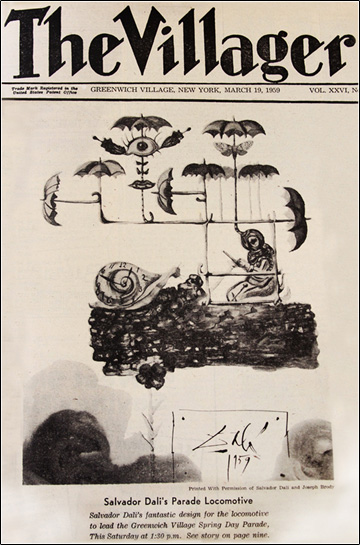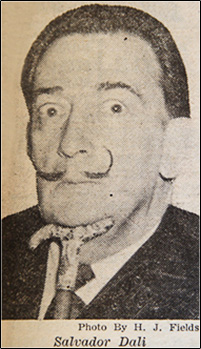Salvador Dali
The Loconik first appeared on Saturday afternoon, March 21st, 1959, at 1:30 p.m., leading the Greenwich Village Spring Day Parade – its appearance there sponsored by Joseph Brody.

From The Villager, March 19, 1959
William H. Honan of The Villager, a co-sponsor of the parade, interviewed Dalí, in his room at the St. Regis Hotel, on the Loconik, in advance of its appearance:

Salvador Dalí’s two-pronged waxed moustache was immediately recognizable. He is a short, rather stocky man with long, black hair…. [Dalí’s] room was cluttered. On the left, as we entered, there was a tray of oil tubes and an easel supporting a fresh canvas on which several delicate blue and yellow butterflies had been painted. To the right: a desk piled with photographs, and a small table jammed with, among other things, a huge snail shell with a light inside…. We sat down in a circle….
“We’re delighted with your contribution to the parade,” I started, “but we’re not quite clear about its exact meaning or purpose.”
Dalí’s face lit up. I couldn’t have said anything more flattering.
“Confusion! Dalí creates confusion!” he exclaimed. “And if you’re not any clearer after we talk, call me tomorrow and I’ll offer you more obscurity.”
Accepting him at his word, I asked if he would kindly confuse me about the umbrellas on his locomotive.
“Dalí all the time creates the contrary of everything,” he said. “The umbrellas mean pleasure…. The umbrella is the skeleton on the outside,” he said, “like a lobster…and the umbrellas should have water coming out of them, instead of falling on them.”
Mr. Mardus [the parade coordinator] interrupted here to note the great cost of creating umbrellas that would rain themselves instead of just conventionally resist rain. Couldn’t Dalí use soap bubbles instead?, he suggested.
“Soap boobles?” repeated the master. “Yes, Dalí is also a diplomat. We shall have soap boobles. Inside Dalí’s locomotive, it is snowing!” But he warned us that if the locomotive were not built according to this design in all other respects, he would not ride on it during the parade.
Mr. Mardus explained that a crew of men were working night and day to build the locomotive on schedule for the parade this Saturday. “The more the builders suffer,” Dalí replied, “the better Dalí’s locomotive will be. It is not easy to build this rhythm of confusion which is poetry….”
The more we scratched our heads, the more enthusiastic Dalí became. He told us that the chassis of the locomotive was to be made of real coal because coal is “man’s subconscious” and also the “source of all energy.” He had wanted to build the locomotive ten stories high. He had wanted it to “breathe” like an animal. Any nation that can send a rocket into space, he said, can certainly build his locomotive…..
I realized I hadn’t asked about the great eye or the lips on the locomotive…. He listened to my question about the eyes and lips, paused a moment, and said, “Dalí’s locomotive has sex appeal!”
….We reported [to Brody] on the conversation with Dalí. “The man is fabulous, really fabulous,” said Brody. Incidently, “what are you spending on all this? I asked. Brody smiled painfully. “Back in September,” he said, “when I conceived of the idea, I planned to spend $4,000. Now Dalí’s locomotive will cost $16,000…. But Dalí is charging me nothing,” Brody added. “He’s doing it for the community. He loves The Village. So do I. I’ve made my fortune there. I want to give something back to the people.”




















